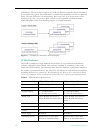
Network Video Recording
ETV Portal Server Admin Guide 129
NVR Performance Considerations
The NVR 40 lets you record any combination of up to 40 MPEG, WM, and H.264 streams at
a time. There are however performance considerations when recording multiple,
simultaneous, high-rate MPEG-2, WM, or H.264 streams. At MPEG-2 rates up to 5.5Mbps
or WM rates up to 1.2Mbps 40 simultaneous recordings are supported. At higher rates
however the full licensing capacity cannot be used. For example, when using the
Best Quality
WM template at 4.5Mbps, 10 simultaneous records are supported; when using MPEG-2 at
15Mbps, 15 simultaneous recordings are supported.
NVR Types
Standard NVR
A Standard NVR's record capability is managed by a Portal Server or Standalone NVR. In a
standard NVR installation, the full Portal Server or Standalone NVR application is installed
on one machine and the NVR application is installed on a separate machine. If you need to
add recording capacity, you can add multiple NVRs as necessary. You use the Portal Server or
a Standalone NVR application to configure the Standard NVR (see Configuring a Standard
NVR). A standard NVR has these characteristics:
• supports record only.
• records 10 or 40 concurrent streams depending on license.
• is configured with the standard Portal Server Admin Console or the Standalone NVR
Console.
•records from the
Record button or the Scheduler module.
• Supports "batch" recording where one large file is recorded into multiple smaller files.
Standalone NVR
A Standalone NVR manages the record capability of itself and any attached Standard NVRs.
A standalone NVR is typically used in security, surveillance, and monitoring applications or anywhere
where full Portal Server functionality is not required. In a standalone NVR installation, a subset of
the Portal Server application is installed on one machine and the NVR application is installed
on the same machine or on a different machine. If you need to add recording capacity, you can
add multiple Standard NVRs necessary. You use the subset of the Portal Server application to
configure the NVR (see Configuring a Standalone NVR
). A standalone NVR has these
characteristics:
• supports record only.
• records 10 or 40 concurrent streams depending on license.
• is configured with a subset of the Portal Server Admin Console that has limited
features—no VBricks, IPRs, etc.
•records from the
Scheduler module only.
• has limited end user features. End users can see only the
Scheduler, the Status page, and
the
Help system.
• supports "batch" recording where one large file is recorded into multiple smaller files.
Note When purchasing additional NVRs, VBrick provides a single combined license that
includes recording capacity for all NVRs onsite.


















